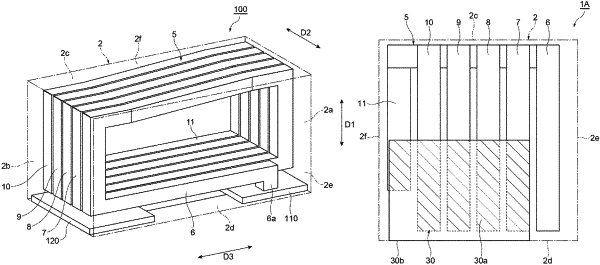| CPC H01F 27/292 (2013.01) [H01F 17/0013 (2013.01); H01F 27/2847 (2013.01); H01F 2017/0073 (2013.01)] | 3 Claims |

|
1. A coil component comprising:
an element body including a pair of end surfaces facing each other, a pair of main surfaces facing each other, and a pair of side surfaces facing each other;
a coil disposed in the element body, having a coil axis extending along a facing direction of the pair of side surfaces, the coil including:
a first outermost turn closest to one of the side surfaces in the facing direction of the pair of side surfaces;
a second outermost turn closest to the other side surface in the facing direction of the pair of side surfaces; and
a plurality of inner turns between the first outermost turn and the second outermost turn;
a first external electrode to which an end portion of the first outermost turn is connected; and
a second external electrode to which an end portion of the second outermost turn is connected, wherein
each of the first external electrode and the second external electrode is disposed on at least one of the main surfaces and the first external electrode and the second external electrode are separated from each other in a facing direction of the pair of end surfaces, and
in a facing direction of the pair of main surfaces, each of the plurality of inner turns overlaps the second electrode more than the first outermost turn overlaps the second electrode, and each of the plurality of inner turns overlaps the first electrode more than the second outermost turn overlaps the first electrode.
|